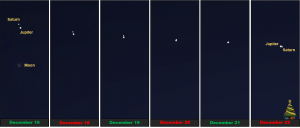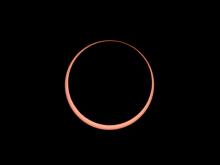Jupiter and Saturn, the largest planets in the solar system, are moving closer and closer together in the western evening sky. They will be closest together on December 21, when they will appear to almost touch each other. The Moon joins them on the 16th. After that, the separation will grow, although they'll still form a close pair for Christmas Eve and Christmas night.
You are here
Moon and Planets
There’s quite a logjam in the southwestern sky after sunset the next couple of evenings. The crescent Moon will pass by Jupiter and Saturn. The planets are so close together that it looks like they’re about to slam into each other.
Jupiter and Saturn will get even closer to each other over the next few nights. They’ll be barely a whisker apart on Monday. After that, they’ll start to separate. They won’t come together again for 20 years.
Both planets are dropping toward the Sun. They’ll pass behind the Sun as seen from Earth in late January — a position called superior conjunction. After that, they’ll start to climb into the morning sky.
Jupiter is by far the brighter of the two planets. In fact, it’s the brightest object in the entire night sky other than the Moon and the planet Venus, which currently is the “morning star.” In part, that’s because Jupiter’s the biggest planet in the solar system — about 11 times the diameter of Earth. And it’s topped by bright clouds.
Saturn is much fainter than Jupiter. It’s a little smaller than Jupiter, and it’s almost twice as far away. But it’s also topped by bright clouds. And its wide, beautiful rings add a bit to its luster, making it an easy target in the early evening sky.
Tonight, look for Jupiter and Saturn a little above the Moon. Tomorrow night they’ll be to the lower right of the Moon — and even closer together.
We’ll have more about Saturn tomorrow.
Script by Damond Benningfield
Get Premium Audio
Listen to today's episode of StarDate on the web the same day it airs in high-quality streaming audio without any extra ads or announcements. Choose a $8 one-month pass, or listen every day for a year for just $30.







